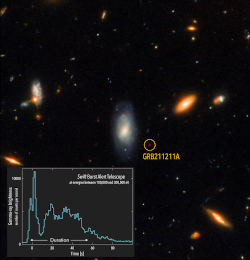HEAPOW: The Long and Short of It (2022 Dec 19)
Posted: Tue Dec 20, 2022 4:10 pm
 HEAPOW: The Long and Short of It (2022 Dec 19)
HEAPOW: The Long and Short of It (2022 Dec 19)
Gamma-ray bursts (GRBs), those mysterious titanic explosions discovered by chance in the 1960's by the Vela satellites (designed to detect evidence of titanic explosions on earth), have puzzled scientists for decades. Our understanding of GRBs has clarified over the past 30 years: the pinpointing by the SAX space observatory of a Gamma-ray burst in another galaxy, showing that at least some of these events were extragalactic and therefore extremely powerful; establishing that gamma-ray bursts divided into "long" bursts and "short" bursts lasting less than a few seconds by the Compton Gamma-ray Observatory and the Fermi Gamma-ray Space Telescope; and discovering that some short gamma-ray bursts were associated with the emission of gravitational radiation by Fermi, INTEGRAL, and LIGO, which connected short gamma-ray bursts with a "kilonova", the merger of two neutron stars. Thus the generally accepted view is that short GRBs and long ones are fundamentally different: short bursts signal the merger of neutron stars, while long bursts signal the explosion of a very massive star at the end of the star's life. But for every rule there is an exception, of course. On December 11, 2021, the Neil Gehrels Swift Observatory and Fermi detected a long GRB lasting about 100 seconds. Follow-up observations by two independent teams of scientists using the Gemini North and Gemini South telescopes, and other ground-based facilities, discovered strong evidence that this long burst came from a kilonova event. In particular, the ground-based observations revealed a tell-tale near-infrared afterglow at the precise location of the GRB. This infrared afterglow is believed to be a signal of the production of heavy elements (like gold) created in a kilonova. The image above shows the position of the mysterious GRB, while the inset shows the burst of gamma-rays detected by Swift over the duration of the burst. If this GRB was truly produced by a merger of neutron stars, the fundamental question is: why did it last so long?
| << Previous HEAPOW | High Energy Astrophysics Picture of the Week | Next HEAPOW >> |
